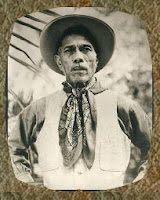100 Years of Waimea Cowboys
There is a virgins’ heiau here in the puu (hills) above Waimea (and that is why it is called Red Water). A young goddess (Wao?) met the young god from Kahiki on this spot and they fell instantly in love. Later she came back to have her babies here. Her helpers would roll a stone down the mountain to see the spot where she would give birth, and her helpers were stones.Women and girls trained here to heal and be midwives at the heiau.

Haleino Heiau:
“The only heiau ever founded, dedicated and consecrated by a woman, the High
Chiefess Hoopiliahae, an ancestor of the Sovereigns of Hawaii and the ruling High
Chiefs of Waimea” (5) “noted for the red rain and vivid rainbow symbols of the
sacredness of this locality, was exclusively for girls of the age of purity who
performed the duties of dedicating and participating in the different ceremonies, in
which the spirit of love, purity of body and mind was imbued; also the science of
healing was taught, thus consecrating their lives for the betterment of others.”
(2)
Hōkū’ula, lit., red star (8), also, hill of the red planet (2)Residence of the akua (god) Makuakuamana, who came with Paao the High Priest from Kahiki, and his wife, High Chiefess (also, beautiful goddess) Wao.
From Waimea Place Names
About 30 women and girls from the community did some beautiful kahiko hula and chant about Waimea—my baby was entranced—I don’t think she blinked the whole time. I love Kahiko hula—I love the dissonant harmonies of the chanting, the strong brassy voices and the
beautiful movements—all those strong bodies in unison, and folded up in the
yards of cloth. Gorgeous. I love watching pur friend Pomai dance especially—she is
like a goddess herself—6 feet tall and all fierce power and grace.
The hula consecrated the evening-- the last line they chanted was, "Victorious are the children of Waimea!" and they shot their arms out in front of them like Ikua's leather lariate lassoo, and roped the audience's attention and power. That energy remained taut the whole night.
Dr. Billy Bergin took over the podium and talked about the history of Waimea, and the 52 Hawaiian families who were awarded the Hawaiian Homes parcels here 50 years ago. Parker Ranch gave up the best pasture, and even donated the labor and fenced each parcel off with the longlasting ohia posts. Those families make Waimea what it is-- braided together with common histories and intermarriage, their grandkids put the photos on the walls.
Dr. Bergin said, "A thousand years ago, Waimea was Hawaiian. It is Hawaiian today, and in a thousand years, it will still be Hawaiian." The crowd cheered for a long time.
After his talk, the musicians came up to the stage and played all of the Big Island songs, the Waimea songs, the Paniolo songs. It was perfect: the improvised paani (solos), the bright ukulele, the slack key guitar. The lead guitarist retuned partway through and summarized succinctly: "The mexicans come over playing their guitars, the Hawaiians sit there and playing with the keys, that's why it's slack key, yee-haw!"


Comments
Post a Comment